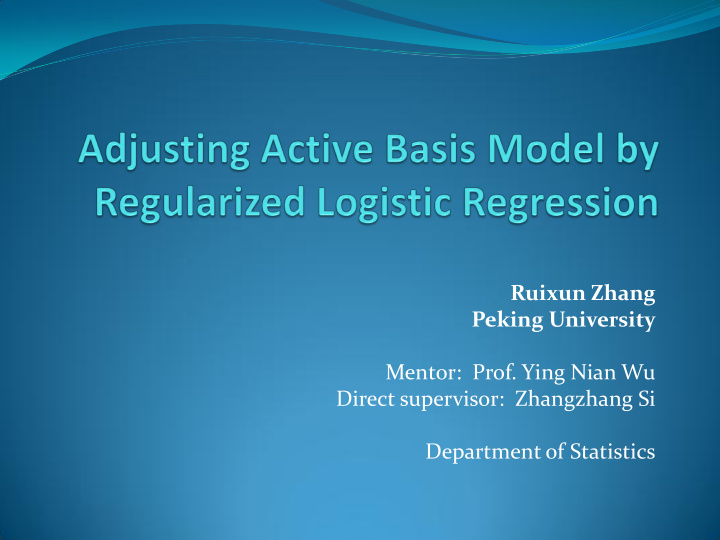



Ruixun Zhang Peking University Mentor: Prof. Ying Nian Wu Direct supervisor: Zhangzhang Si Department of Statistics
Outline Active Basis model as a generative model Supervised and unsupervised learning Hidden variables and maximum likelihood Discriminative adjustment after generative learning Logistic regression, SVM and AdaBoost Over-fitting and regularization Experiment results
Active Basis – Representation An active basis consists of a small number of Gabor wavelet elements at selected locations and orientations Common template: B ( B i , 1,..., ) n i n I c B U m m i , m i , m i 1 B B i , 1,2,..., n m i , i
Active Basis – Learning and Inference Template : B ( B , i 1 ,..., n ), and ( , i 1 ,..., n ) i i Shared sketch algorithm Local normalization measures the i importance of B i Inference: matching the template at each pixel, and select the highest score.
Active Basis – Example
General Problem – Unsupervised Learning Unknown categories – mixture model Unknown locations and scales Hidden variables Basis perturbations ……………… Active plates – a hierarchical active basis model
Starting from Supervised Learning Data set: head_shoulder, 131 positives, 631 negatives. ………………
Active Basis as a Generative Model Active basis – Generative model Likelihood-based learning and inference Discover hidden variables – important for unsupervised learning. NOT focus on classification task (no info from negative examples.) Discriminative model Not sharp enough to infer hidden variables Only focus on classification Over-fitting.
Discriminative Adjustment Adjust λ’s of the template B ( B i : 1,..., ) n i Logistic regression – consequence of generative model p 1 ( 1) P y λ x T 1 exp( y b ( )) p λ x T or equivalently logit( ) p ln 1 b p y f N P λ x λ x T Loss function: T y b ( ) f ( b ) log(1 e ) i i depends on different method 1 i
Logistic Regression Vs. Other Methods Logsitic regression Loss SVM AdaBoost y f
Problem: Over-fitting head_shoulder; svm from svm-light, logistic regression from matlab. template size 80, training negatives 160 , testing negatives 471 . active basis active basis + logistic regression active basis + SVM active basis + AdaBoost
Regularization for Logsitic Regression Loss function for N P T λ x λ y ( b ) C log(1 e ) L1-regularization i i 1 i 1 N P 1 L2-regularization T λ x λ λ y ( b ) T C log(1 e ) i i 2 i 1 Corresponding to a Gaussian prior Regularization without the intercept term
Experiment Results head_shoulder; svm from svm-light, L2-logistic regression from liblinear. template size 80, training negatives 160 , testing negatives 471 . active basis active basis + logistic regression active basis + SVM active basis + AdaBoost Tuning parameter C=0.01 . Intel Core i5 CPU, RAM 4GB, 64bit windows # pos Learning time (s) LR time (s) 5 0.338 0.010 10 0.688 0.015 20 1.444 0.015 40 2.619 0.014 80 5.572 0.013
With or Without Local Normalization All settings same as the head_shoulder experiment With Without
Tuning Parameter All settings the same. Change C, see effect of L2-regularization
Experiment Results – More Data horses; svm from svm-light, L2-logistic regression from liblinear. template size 80, training negatives 160 , testing negatives 471 . active basis active basis + logistic regression active basis + SVM active basis + AdaBoost Dimension reduction by active basis, so speed is fast. Tuning parameter C=0.01 .
Experiment Results – More Data guitar; svm from svm-light, L2-logistic regression from liblinear. template size 80, training negatives 160 , testing negatives 855 . active basis active basis + logistic regression active basis + SVM active basis + AdaBoost Dimension reduction by active basis, so speed is fast. Tuning parameter C=0.01 .
Future Work Extend to unsupervised learning – adjust mixture model Generative learning by active basis Hidden variables Discriminative adjustment on feature weights Tighten up the parameters, Improve classification performances Adjust active plate model
Acknowledgements Prof. Ying Nian Wu Zhangzhang Si Dr. Chih-Jen Lin CSST program
Refrences Wu, Y. N., Si, Z., Gong, H. and Zhu, S.-C. (2009). Learning Active Basis Model for Object Detection and Recognition. International Journal of Computer Vision. R.-E. Fan, K.-W. Chang, C.-J. Hsieh, X.-R. Wang, and C.-J. Lin. (2008). LIBLINEAR: A Library for Large Linear Classification. Journal of Machine Learning Research. Lin, C. J., Weng, R.C., Keerthi, S.S. (2008). Trust Region Newton Method for Large-Scale Logistic Regression. Journal of Machine Learning Research. Vapnik, V. N. (1995). The Nature of Statistical Learning Theory. Springer. Joachims, T. (1999). Making large-Scale SVM Learning Practical. Advances in Kernel Methods - Support Vector Learning, B. Schölkopf and C. Burges and A. Smola (ed.), MIT-Press. Freund, Y. and Schapire, R. E. (1997). A Decision-Theoretic Generalization of On-Line Learning and an Application to Boosting. Journal of Computer and System Sciences. Viola, P. and Jones, M. J. (2004). Robust real-time face detection. International Journal of Computer Vision. Rosset, S., Zhu, J., Hastie, T. (2004). Boosting as a Regularized Path to a Maximum Margin Classifier. Journal of Machine Learning Research. Zhu, J. and Hastie, T. (2005). Kernel Logistic Regression and the Import Vector Machine. Journal of Computational and Graphical Statistics. Hastie, T., Tibshirani, R. and Friedman, J. (2001) Elements of Statistical Learning; Data Mining, Inference, and Prediction. New York: Springer. Bishop, C. (2006). Pattern Recognition and Machine Learning. New York: Springer. L. Fei-Fei, R. Fergus and P. Perona. (2004). Learning generative visual models from few training examples: an incremental Bayesian approach tested on 101 object categories. IEEE. CVPR, Workshop on Generative-Model Based Vision. Friedman, J., Hastie, T. and Tibshirani, R. (2000). Additive logistic regression: A statistical view of boosting (with discussion). Ann. Statist.
Thank you. Q & A
Recommend
More recommend